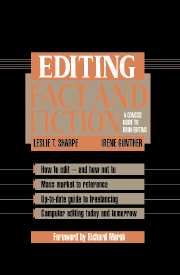Book contents
- Frontmatter
- Contents
- Foreword
- Acknowledgments
- Introduction
- Chapter 1 Who (and What) Is an Editor?
- Chapter 2 Fact or Fiction? Finding Your Niche
- Chapter 3 Principles to Edit By
- Chapter 4 The Editor's Senses
- Chapter 5 The Editor's Sensibility
- Chapter 6 A Guide to Editorial Freelancing
- Chapter 7 Electronic Editing Today and Tomorrow
- Chapter 8 Tools of the Trade and How to Use Them
- Index
Chapter 3 - Principles to Edit By
Published online by Cambridge University Press: 21 September 2009
- Frontmatter
- Contents
- Foreword
- Acknowledgments
- Introduction
- Chapter 1 Who (and What) Is an Editor?
- Chapter 2 Fact or Fiction? Finding Your Niche
- Chapter 3 Principles to Edit By
- Chapter 4 The Editor's Senses
- Chapter 5 The Editor's Sensibility
- Chapter 6 A Guide to Editorial Freelancing
- Chapter 7 Electronic Editing Today and Tomorrow
- Chapter 8 Tools of the Trade and How to Use Them
- Index
Summary
The intellectual challenge is always there, but more than anything else, editing is fun–so much fun that it's easy to get carried away.
–Mary StoughtonEditing itself is an excruciating act of self-discipline, mind-reading, and stable cleaning. If it seems like a pleasure, something is probably wrong.
–Arthur PlotnikYou're an editorial assistant in a mass-market publishing house who has been on the job for nine months. You're a junior member of an encyclopedia department who has recently been promoted to assistant editor. You're a freelance proofreader who has passed a copyediting test. The three of you have one thing in common. You have just been given your first manuscript to edit.
Your assignments are somewhat different, and so are your instructions. You, the editorial assistant, have been told to line edit a mystery novel; you, the assistant editor, have been handed an article for an encyclopedia yearbook on the year's highlights in television and given free rein to do “whatever needs to be done” with it. You, the freelance proofreader who aspires to be a copyeditor, have had a short manuscript entitled Ten Easy Ways to Improve Your Self-image delivered to your door with a note saying that all it needs is “a little light line editing.”
All three of you have done your homework. The editorial assistant has gleaned nuggets of editing wisdom from her boss by reading his scrawled pencil comments in the margins of manuscripts and by carefully studying his queries to authors.
- Type
- Chapter
- Information
- Editing Fact and FictionA Concise Guide to Book Editing, pp. 77 - 101Publisher: Cambridge University PressPrint publication year: 1994



